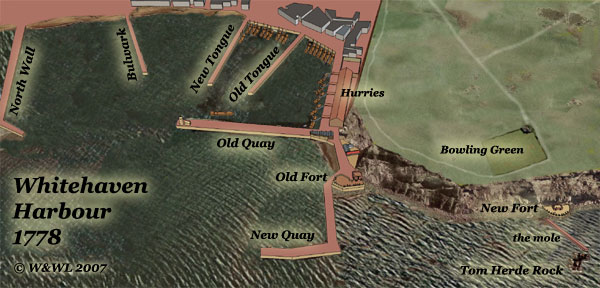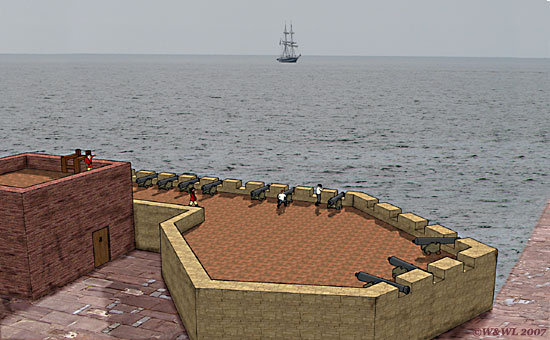
Whitehaven harbour in the time of John Paul Jones was not a lot different than it is today if you remove the two longest piers. The oldest part of the harbour was Old Quay constructed over 100 years earlier. At its end was a watchtower built in the 1730’s and next to that was a building for the pier master built in 1764. The North Wall was still under construction, after many debates about its final nature, but had probably reached the point of heading back towards the Old Quay thus largely enclosing the harbour.

Within this main harbour the area was divided by piers projecting seawards from the town, which facilitated the unloading of cargoes to be transported to the numerous warehouses along the front and many more in the town. The oldest of these piers, seen on Mathias Read's Birds Eye View of the 1730’s, was called Old Tongue and also known as the Merchant's Quay but is now known as the Sugar Tongue. The next one by reason was called the New Tongue (now Lime Tongue) which extended from near the end of Marlborough Street. The final projection, called the Bulwark, was from the end of Duke St heading towards the end of the Old Quay. The town end of this appears to pre-date the others but it was later extended. Projecting seawards beyond the Old Quay was a dogleg pier, known unimaginatively as the New Quay, which had been built about 1740. (Incidentally, this is now known by the cumbersome title of Old New Quay.)

The Old Fort, which is now quite a long way from the shore, was then right up to the high water mark. Originally, it would have had a clear panorama of the harbour entrance but the New Quay must have interrupted this. It contained several large cannon known as 42-pounders similar in size to Long Tom now mounted on the South shore.

The Lunette battery, an impressive semi-circular gun platform, lay behind Tom Herds rock. Also known as the New Fort, it also contained several large cannon. Between Tom Herds rock and the shore there was a small wall, known as the mole, to help provide more shelter to the harbour. The rock itself would no doubt have been slightly more prominent than it is today after over 200 years of battering by the sea.
Between the Old Quay and the town most of the length of the West quay was occupied by coal staithes known as the Hurries. This massive structure was longer than a football pitch and taller than a 3-storey building. The upper level had a covered wagon-way with shoots down which the coal was loaded into the ships, but below was also a storage reservoir that could hold up to 6,500 tons of coal. It was near this that the Thompson was moored.
Also on West Strand was a shed that housed the fire engines, which were fortunately situated, to put out the fire caused by John Paul Jones.
©W&WL 2007